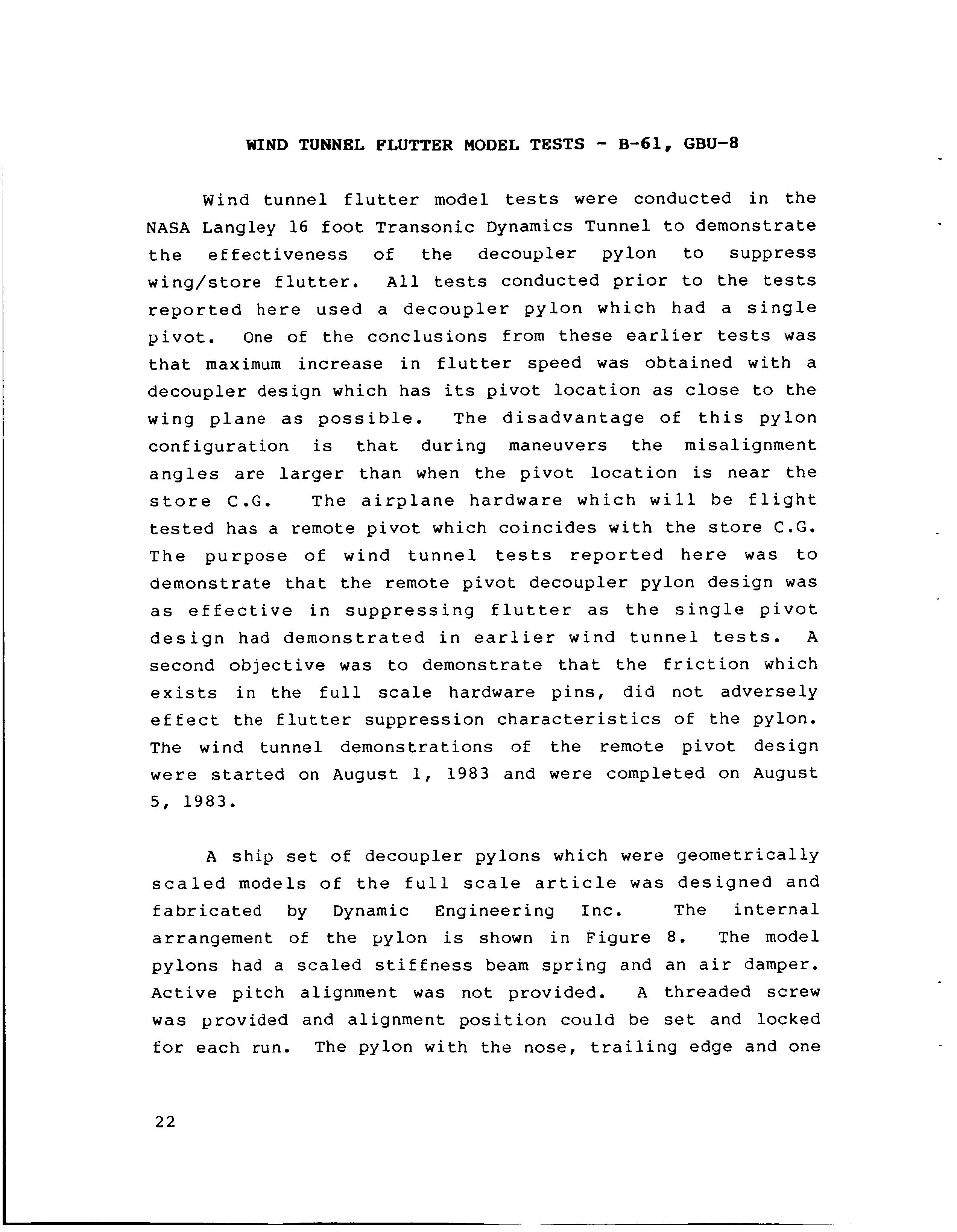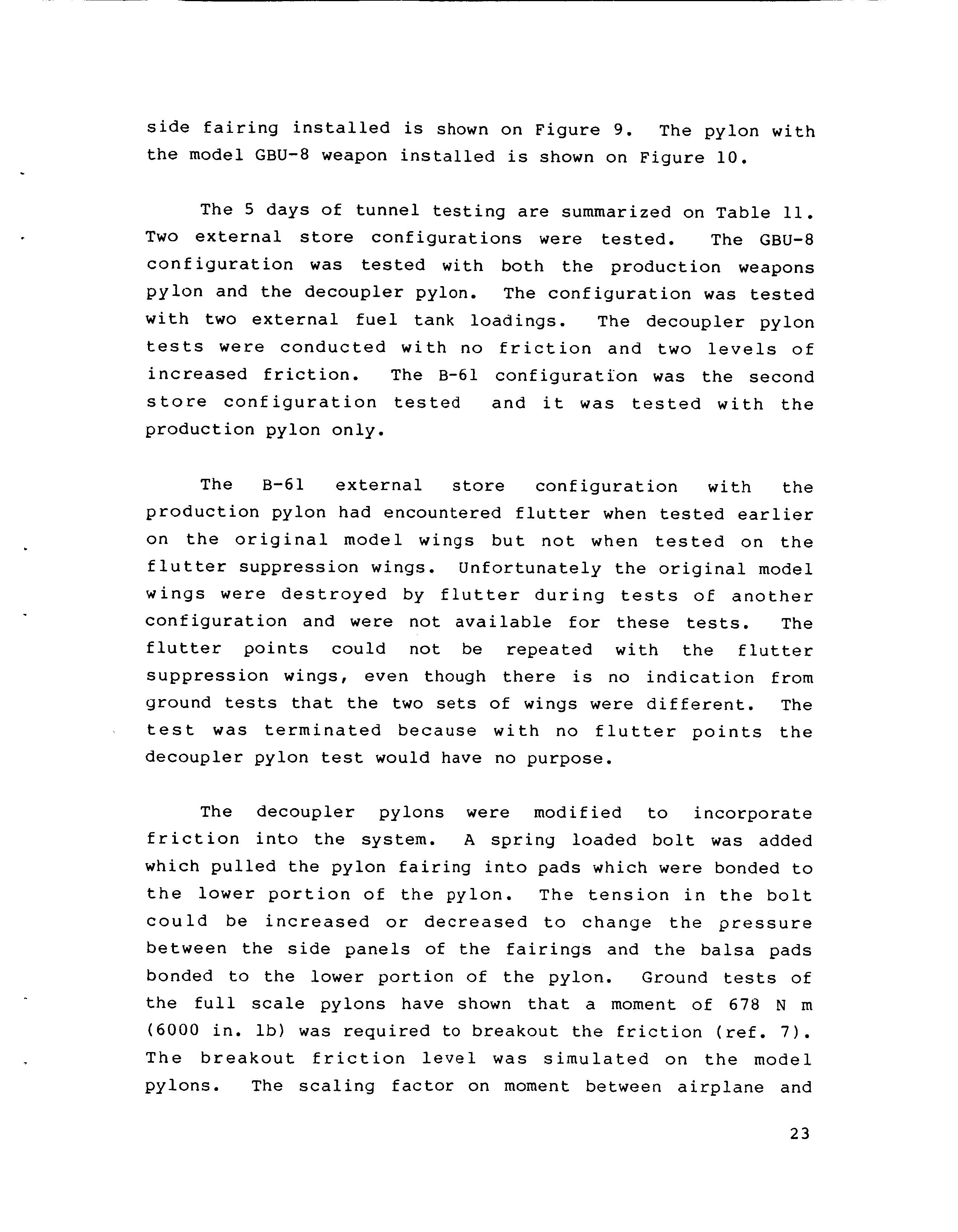
5 minute read
WIND TUNNEL FLUTTER MODEL TESTS B-61, GBU-8
from NASA Technical Reports Server (NTRS) 19870001427: Design and fabrication of the NASA decoupler pylon
WIND TUNNEL FLUTTER MODEL TESTS - B-61, GBU-8
Wind tunnel flutter model tests were conducted in the NASA Langley 16 foot Transonic Dynamics Tunnel to demonstrate the effectiveness of the decoupler pylon to suppress wing/store flutter. All tests conducted prior to the tests reported here used a decoupler pylon which had a single pivot. One of the conclusions from these earlier tests was that maximum increase in flutter speed was obtained with a decoupler design which has its pivot location as close to the wing plane as possible. The disadvantage of this pylon configuration is that during maneuvers the misalignment angles are larger than when the pivot location is near the store C.G. The airplane hardware which will be flight tested has a remote pivot which coincides with the store C.G. The purpose of wind tunnel tests reported here was to demonstrate that the remote pivot decoupler pylon design was as effective in suppressing flutter as the single pivot design had demonstrated in earlier wind tunnel tests. A second objective was to demonstrate that the friction which exists in the full scale hardware pins, did not adversely effect the flutter suppression characteristics of the pylon. The wind tunnel demonstrations of the remote pivot design were started on August 1, 1983 and were completed on August 5, 1983.
Advertisement
A ship set of decoupler pylons which were geometrically scaled models of the full scale article was designed and fabricated by Dynamic Engineering Inc. The internal arrangement of the pylon is shown in Figure 8. The model pylons had a scaled stiffness beam spring and an air damper. Active pitch alignment was not provided. A threaded screw was provided and alignment position could be set and locked for each run. The pylon with the nose, trailing edge and one
22
side fairing installed is shown on Figure 9. The pylon with the model GBU-8 weapon installed is shown on Figure 10.
The 5 days of tunnel testing are summarized on Table 11. Two external store configurations were tested. The GBU-8 configuration was tested with both the production weapons pylon and the decoupler pylon. The configuration was tested with two external fuel tank loadings. The decoupler pylon tests were conducted with no friction and two levels of increased friction. The B-61 configuration was the second store configuration tested and it was tested with the production pylon only.
The B-61 external store configuration with the production pylon had encountered flutter when tested earlier on the original model wings but not when tested on the flutter suppression wings. Unfortunately the original model wings were destroyed by flutter during tests of another configuration and were not available for these tests. The flutter points could not be repeated with the flutter suppression wings, even though there is no indication from ground tests that the two sets of wings were different. The test was terminated because with no flutter points the decoupler pylon test would have no purpose.
The decoupler pylons were modified to incorporate friction into the system. A spring loaded bolt was added which pulled the pylon fairing into pads which were bonded to the lower portion of the pylon. The tension in the bolt could be increased or decreased to change the pressure between the side panels of the fairings and the balsa pads bonded to the lower portion of the pylon. Ground tests of the full scale pylons have shown that a moment of 678 N m (6000 in. lb) was required to breakout the friction (ref. 7). The breakout friction level was simulated on the model pylons. The scaling factor on moment between airplane and
23

model is 429.64. The airplane to model scaling factors are shown in Reference 9. The moment on the model is:
678 429.6 = 1.578 N m (13.96 in.lb)
The decoupler pylons were mounted in a fixture to apply this moment. A plate was bolted to the bottom of the pylons which had a load application point which was 26.03 cm (10.25 inches) forward of the linkage apex. The load required at this point is:
-- 1*578 - 6.06 N (1.36 lbs) .2603
The tension spring was set and locked so that at 4.448 N (1 lb) of load breakout did not occur and at 6.09 N (1.37 lbs) breakout occurred. The breakout status was obtained by monitoring the spring strain gage. Both pylons were set with this same level of breakout friction.
After completing Run No. 39 (Table 111, the decoupler pylons were removed from the model and the breakout friction was checked. The friction was the same as before Run No. 38. The friction was increased to a level which was twice the level tested on runs 38 and 39. This increased friction was accomplished by increasing the tension in the bolts in the pylon fairing. The tension was increased until the breakout would not occur at 8.896 N (2 lbs) of load at 26.03 cm (10.25 inches) from the pylon apex, and would breakout at 12.23 N (2.75 lbs). Both pylons were set and locked using this criteria.
24

After completing Run No. 41 (Table 111, the decoupler pylons were removed from the model and the breakout friction was checked on pylon No. 2 (right hand side). The pylon would not breakout with 6.672 N (1.5 lbs) of weight and would breakout with 7.784 N (1.75 lbs). This test indicated that the friction which was in the pylons at the beginning of run No. 41 had been reduced during the run. There was an indication that the friction surfaces were more polished than before the run.
The conclusions which were obtained from the five days of wind tunnel tests are that the decoupler pylon with a remote pivot is just as effective in increasing the wing/store flutter speed as the single pivot pylon design is. Also, increased friction in the pylon pivot to levels comparable to the full scale hardware, does not effect the capability of the pylon for increasing the flutter speed.
25











